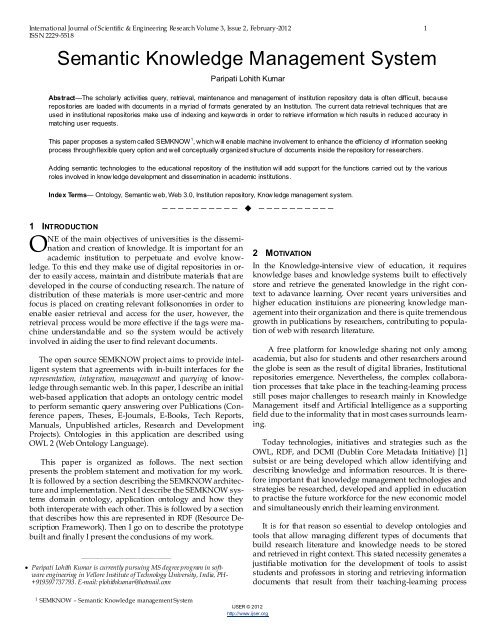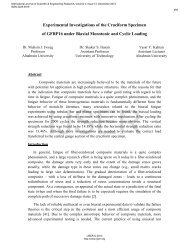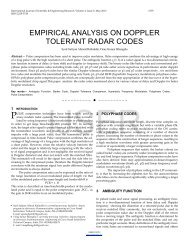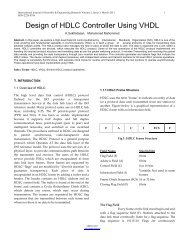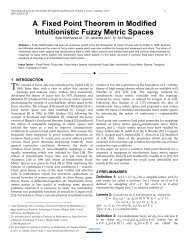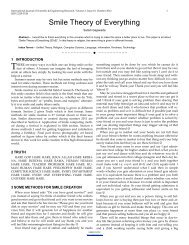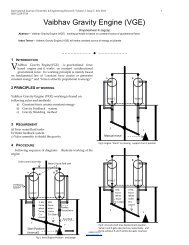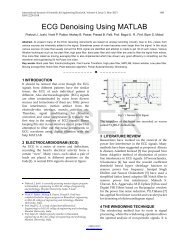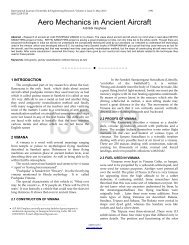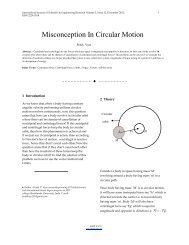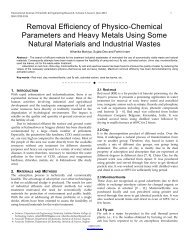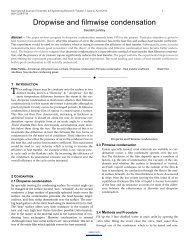Semantic Knowledge Management System - International Journal of ...
Semantic Knowledge Management System - International Journal of ...
Semantic Knowledge Management System - International Journal of ...
You also want an ePaper? Increase the reach of your titles
YUMPU automatically turns print PDFs into web optimized ePapers that Google loves.
<strong>International</strong> <strong>Journal</strong> <strong>of</strong> Scientific & Engineering Research Volume 3, Issue 2, February-2012 1<br />
ISSN 2229-5518<br />
<strong>Semantic</strong> <strong>Knowledge</strong> <strong>Management</strong> <strong>System</strong><br />
Paripati Lohith Kumar<br />
Abstract—The scholarly activities query, retrieval, maintenance and management <strong>of</strong> institution repository data is <strong>of</strong>ten difficult, because<br />
repositories are loaded with documents in a myriad <strong>of</strong> formats generated by an Institution. The current data retrieval techniques that are<br />
used in institutional repositories make use <strong>of</strong> indexing and keywords in order to retrieve information w hich results in reduced accuracy in<br />
matching user requests.<br />
This paper proposes a system called SEMKNOW 1 , which will enable machine involvement to enhance the efficiency <strong>of</strong> information seeking<br />
process through flexible query option and well conceptually organized structure <strong>of</strong> documents inside the repository for researchers.<br />
Adding semantic technologies to the educational repository <strong>of</strong> the institution will add support for the functions carried out by the various<br />
roles involved in know ledge development and dissemination in academic institutions.<br />
Index Terms— Ontology, <strong>Semantic</strong> web, Web 3.0, Institution repository, Know ledge management system.<br />
—————————— ——————————<br />
1 INTRODUCTION<br />
O<br />
NE <strong>of</strong> the main objectives <strong>of</strong> universities is the dissemination<br />
and creation <strong>of</strong> knowledge. It is important for an<br />
academic institution to perpetuate and evolve knowledge.<br />
To this end they make use <strong>of</strong> digital repositories in order<br />
to easily access, maintain and distribute materials that are<br />
developed in the course <strong>of</strong> conducting research. The nature <strong>of</strong><br />
distribution <strong>of</strong> these materials is more user-centric and more<br />
focus is placed on creating relevant folksonomies in order to<br />
enable easier retrieval and access for the user, however, the<br />
retrieval process would be more effective if the tags were machine<br />
understandable and so the system would be actively<br />
involved in aiding the user to find relevant documents.<br />
The open source SEMKNOW project aims to provide intelligent<br />
system that agreements with in-built interfaces for the<br />
representation, integration, management and querying <strong>of</strong> knowledge<br />
through semantic web. In this paper, I describe an initial<br />
web-based application that adopts an ontology centric model<br />
to perform semantic query answering over Publications (Conference<br />
papers, Theses, E-<strong>Journal</strong>s, E-Books, Tech Reports,<br />
Manuals, Unpublished articles, Research and Development<br />
Projects). Ontologies in this application are described using<br />
OWL 2 (Web Ontology Language).<br />
This paper is organized as follows. The next section<br />
presents the problem statement and motivation for my work.<br />
It is followed by a section describing the SEMKNOW architecture<br />
and implementation. Next I describe the SEMKNOW systems<br />
domain ontology, application ontology and how they<br />
both interoperate with each other. This is followed by a section<br />
that describes how this are represented in RDF (Resource Description<br />
Framework). Then I go on to describe the prototype<br />
built and finally I present the conclusions <strong>of</strong> my work.<br />
————————————————<br />
Paripati Lohith Kumar is currently pursuing MS degree program in s<strong>of</strong>tware<br />
engineering in Vellore Institute <strong>of</strong> Technology University, India, PH-<br />
+919597737793. E-mail: plohithkumar@hotmail.com<br />
2 MOTIVATION<br />
In the <strong>Knowledge</strong>-intensive view <strong>of</strong> education, it requires<br />
knowledge bases and knowledge systems built to effectively<br />
store and retrieve the generated knowledge in the right context<br />
to adavance learning. Over recent years universities and<br />
higher education instituions are pioneering knowledge management<br />
into their organization and there is quite tremendous<br />
growth in publications by researchers, contributing to population<br />
<strong>of</strong> web with research literature.<br />
A free platform for knowledge sharing not only among<br />
academia, but also for students and other researchers around<br />
the globe is seen as the result <strong>of</strong> digital libraries, Institutional<br />
repositories emergence. Nevertheless, the complex collaboration<br />
processes that take place in the teaching-learning process<br />
still poses major challenges to research mainly in <strong>Knowledge</strong><br />
<strong>Management</strong> itself and Artificial Intelligence as a supporting<br />
field due to the informality that in most cases surrounds learning.<br />
Today technologies, initiatives and strategies such as the<br />
OWL, RDF, and DCMI (Dublin Core Metadata Initiative) [1]<br />
subsist or are being developed which allow identifying and<br />
describing knowledge and information resources. It is therefore<br />
important that knowledge management technologies and<br />
strategies be researched, developed and applied in education<br />
to practise the future workforce for the new economic model<br />
and simultaneously enrich their learning environment.<br />
It is for that reason so essential to develop ontologies and<br />
tools that allow managing different types <strong>of</strong> documents that<br />
build research literature and knowledge needs to be stored<br />
and retrieved in right context. This stated necessity generates a<br />
justifiable motivation for the development <strong>of</strong> tools to assist<br />
students and pr<strong>of</strong>essors in storing and retrieving information<br />
documents that result from their teaching-learning process<br />
1<br />
SEMKNOW – <strong>Semantic</strong> <strong>Knowledge</strong> management <strong>System</strong><br />
IJSER © 2012<br />
http://www.ijser.org
<strong>International</strong> <strong>Journal</strong> <strong>of</strong> Scientific & Engineering Research Volume 3, Issue 2, February-2012 2<br />
ISSN 2229-5518<br />
and thus generate knowledge-centric collaboration beyond the<br />
confines <strong>of</strong> classroom.<br />
3 SYSTEM ARCHITECTURE<br />
SEMKNOW was implemented using the Java programming<br />
language and interoperates with other open source and <strong>Semantic</strong><br />
Web technologies [2], including the Sesame 2 Java API,<br />
Pellet 3 and Protégé 4 . The system architecture shown in Fig.1 is<br />
composed <strong>of</strong> several components including an application<br />
aggregator, a web user interface, an ontology repository, an<br />
ontology index, a reasoner that exhibit the inferred relations,<br />
properties, classes and a SeRQL (Sesame RDF Query Language)<br />
query engine for querying a triple store [3].<br />
names. Thus, this component supports partial entity name<br />
matches, and retrieval <strong>of</strong> specific types <strong>of</strong> entities. The current<br />
implementation leverages the speed and power <strong>of</strong> the Lucene<br />
Text Indexer; therefore, it reduces the need for memory data<br />
structures for caching entity metadata.<br />
3.4 SeRQL Query Engine<br />
The SeRQL Query Engine interface provides the ability to<br />
query a triple store repository using SeRQL and to obtain result<br />
set through its API. Implementations for sesame serve as<br />
wrappers for the vendor-specific APIs, hiding them from the<br />
components that use the services.<br />
3.5 Graphical User Interface<br />
The SEMKNOW systems graphical user interface is built on<br />
Java Server Pages (JSP). The user interface has been tested and<br />
operates optimally with IE9, Mozilla Firefox, Google chrome,<br />
Safari 5.<br />
3.6 <strong>Semantic</strong> Reasoner<br />
A semantic reasoner, reasoning engine, rules engine, or simply<br />
a reasoner, is a piece <strong>of</strong> s<strong>of</strong>tware able to infer logical consequences<br />
from a set <strong>of</strong> asserted axioms. Reasoner use first-order<br />
predicate logic to perform reasoning. The semantic reasoner<br />
implemented in system is Pellet.<br />
Fig. 1. SEMKNOW Architecture<br />
3.1 SEMKNOW Aggregator<br />
The SEMKNOW aggregator is the nucleus element <strong>of</strong> the system<br />
which integrates the decoupled relations among systems<br />
modules, operates the system behavior, and manages ontologies<br />
used by the application. The aggregator loads requested<br />
ontology as per the context and the retrieved ontology. The<br />
aggregator enables communication between components. The<br />
manipulation <strong>of</strong> OWL documents and data structures by multiple<br />
SEMKNOW components is facilitated by the Sesame Java<br />
API.<br />
3.2 Ontology Repository<br />
Storage and retrieval <strong>of</strong> URI identified ontologies is supported<br />
by ontology repository. This implementation in SEMKNOW<br />
system uses a sophisticated MySQL database storage.<br />
3.3 Ontology Indexer<br />
The ontology indexer though behaves like lookup table; it<br />
enables fast and easy access to entities in ontology. Indexed<br />
entities include class, property, their types and individual<br />
2<br />
Sesame – http://openrdf.org<br />
3<br />
Pellet – http://clarkparsia.com/pellet<br />
4<br />
Protégé – http://protege.stanford.edu<br />
4 IMPLEMENTATION<br />
SEMKNOW, a <strong>Semantic</strong> web based system is developed with<br />
several new practices and technologies as <strong>of</strong> today. Particular<br />
challenges and issues are focused and solved in this system<br />
when compared to traditional semantic systems or existing<br />
knowledge based semantic systems.<br />
The systems ontology is developed in particular using W3C<br />
approved standards through DC<br />
(http://purl.org/dc/elements/1.1) and BIBO<br />
(http://purl.org/ontology/bibo/) entries. And Imports <strong>of</strong><br />
these namespaces makes SEMKNOW ontology standardized.<br />
And the implementation <strong>of</strong> SEMKNOW system is carried<br />
out considering the Indian universities and educational institutions<br />
running the digital library repositories on relational<br />
databases. The shift from legacy relational databases to semantic<br />
knowledge bases with triple storage is made easy through<br />
R2O mapping <strong>of</strong> tables and their columns with entities <strong>of</strong> ontology<br />
[4]. Alignment API is implemented in the system for<br />
this purpose by maintaining threshold value <strong>of</strong> 0.8 for matching<br />
from relational database to ontology. Fig 2 shows the R2O<br />
mapping between SEMKNOW ontology and relational database.<br />
This approach is <strong>of</strong> high prior importance in the development<br />
phase <strong>of</strong> the proposed system [5]. It encourages all the<br />
developers to move from existing WEB2.0 database driven<br />
IJSER © 2012<br />
http://www.ijser.org
<strong>International</strong> <strong>Journal</strong> <strong>of</strong> Scientific & Engineering Research Volume 3, Issue 2, February-2012 3<br />
ISSN 2229-5518<br />
applications to <strong>Semantic</strong> WEB (WEB3.0) database driven applications<br />
and build a giant WEB.<br />
The system though being developed through JSP (Java<br />
Server Pages) technology for front-end, the standards are validated<br />
in security and maintenance through EJB (Enterprise<br />
Java Beans) technology.<br />
The challenge in this alignment is API starts troubling as<br />
number <strong>of</strong> records increases. This is dealt with R2O mapping<br />
that is efficient even for millions <strong>of</strong> records.<br />
After successful execution <strong>of</strong> R2O, the system ontology will<br />
be loaded with all records from relational database into ontology<br />
as instances.<br />
5 SEMKNOW ONTOLOGY<br />
In process <strong>of</strong> learning by students and researchers various<br />
sources <strong>of</strong> knowledge are being generated in form <strong>of</strong> publications,<br />
articles. Today all this sources <strong>of</strong> information is available<br />
in the internet or in data bases in digital format, which enables<br />
their search and use.<br />
Fig. 2. Mapping between Relational Database and Ontology.<br />
But search returns more efficient results only if it is machine<br />
understandable. This is achieved through ontologies [6], and<br />
so this system is built with specifically designed SEMKNOW<br />
application ontology to store and retrieve all the literature<br />
documents from various heterogeneous databases.<br />
In Fig 2, Left hand-side is the tables and its columns from<br />
relational database. And right hand-side is the ontology with<br />
its classes and properties.<br />
Fig. 4. SEMKNOW Application Ontology.<br />
In Fig 4, the hierarchy is designed through<br />
and properties (ISBN, Author...) <strong>of</strong> instances<br />
for each Class (Book, <strong>Journal</strong> Article...) are defined through<br />
in RDF.<br />
SEMKNOW is built intelligent enough that when a user<br />
deposits a manuscript, the article falls into its category on administrator<br />
approval and application ontology is dynamically<br />
updated and synchronises with triple store.<br />
Fig. 3. R20 mapping.<br />
Fig. 3. R2O Mapping<br />
It’s obvious that there is a tight-bond relation between document<br />
and its topic. To facilitate complete effective search the<br />
different types <strong>of</strong> documents organized in application ontolo-<br />
IJSER © 2012<br />
http://www.ijser.org
<strong>International</strong> <strong>Journal</strong> <strong>of</strong> Scientific & Engineering Research Volume 3, Issue 2, February-2012 4<br />
ISSN 2229-5518<br />
gy are related with a suitable domain-or subject-based ontology<br />
[7]. So for this purpose SEMKNOW domain ontology has<br />
been designed using the ACM digital library hierarchy.<br />
Fig. 5. SEMKNOW Domain Ontology.<br />
Fig 5 represents the domain ontology <strong>of</strong> the system. The<br />
hierarchy in this ontology goes through all the Research categories<br />
and narrows down to Subjects in it. The subjects in this<br />
ontology are represented as instances through .<br />
6 APPLICATION AND DOMAIN ONTOLOGY<br />
INTEROPERATION<br />
The two ontology’s are related with in domain ontology and<br />
in application<br />
ontology.<br />
These relations are established through Ontology mapping<br />
enabling the navigation from TypeOfDocument to SubjectOf-<br />
Document and vice-versa.<br />
SEMKNOW <strong>System</strong> has achieved this with Alignment API.<br />
Name eq method from the API solves the integration with 1.0<br />
threshold value [8]. The following is lines from alignment<br />
code:<br />
xmlns:owl="http://www.w3.org/2002/07/owl#"<br />
<br />
<br />
rdf:about="http://sk_application.owl#ResearchCategory"><br />
<br />
<br />
<br />
Fig. 6: Concept <strong>of</strong> SEMKNOWs Application and Domain<br />
ontology interoperability.<br />
In Fig 6, the left hand side represents the application ontology<br />
and right side is the domain ontology. The instance B1 <strong>of</strong> class<br />
Book has other properties like hasAuthor, hasISBN, hasPublisher..,<br />
besides shown isOfSubject property.<br />
7 PROTOTYPE<br />
The SEMKNOW systems prototype developed in Java<br />
shows that users perceived the system as useful in assisting<br />
research work and the retrieval <strong>of</strong> information is <strong>of</strong> adequate<br />
quality. The system is built with basic services justifying the<br />
objective <strong>of</strong> the system like browsing and semantic querying<br />
[9]. Besides few additional modules are included namely –<br />
7.1 Administrator Module<br />
Metadata <strong>of</strong> new documents can be added and updated<br />
to Institutional repository. The system provides user interface<br />
for admin to populate triple store without having prior knowledge<br />
about adding RDF statements to .owl files every time a<br />
new record to be updated, unlike traditional semantic web<br />
based systems and handles user activities.<br />
Fig 7 shows the representation <strong>of</strong> SEMKNOW triple store<br />
using Sesame MySQL RDF store [10]. Adding new records in<br />
deposit module <strong>of</strong> system dynamically updates repository<br />
IJSER © 2012<br />
http://www.ijser.org
<strong>International</strong> <strong>Journal</strong> <strong>of</strong> Scientific & Engineering Research Volume 3, Issue 2, February-2012 5<br />
ISSN 2229-5518<br />
through Sesame Java API.<br />
Fig. 8. SEMKNOW <strong>System</strong>.<br />
8 CONCLUSIONS AND FUTURE WORK<br />
In this paper, I described the system architecture and general<br />
functionality <strong>of</strong> SEMKNOW, an easy to use semantic webbased<br />
application for the scholars, researchers, and students to<br />
perform scholarly activities. Current work includes semantic<br />
filters enabling content browsing, querying, and knowledgebase<br />
development through deposit module in system, system<br />
internationalisation with multi-language support depending<br />
on geographical location and interactive <strong>Knowledge</strong> collaboration<br />
through discussion forum and blogs.<br />
7.2 Deposit Module<br />
Fig. 7. SEMKNOW Repository<br />
A new document can be added to repository by user<br />
but updated to repository only on admins approval.<br />
7.3 Discussion Forum<br />
<strong>Knowledge</strong> <strong>Management</strong> system is justified on enabling<br />
knowledge collaboration and sharing, that is achieved<br />
through this module.<br />
The ontology engineering greatly helped in enabling the<br />
identification <strong>of</strong> the more significant concepts and relationships<br />
used more <strong>of</strong>ten in a knowledge domain, thus becoming<br />
a prevailing knowledge representation metadata for knowledge<br />
repositories. The main contribution <strong>of</strong> this system has<br />
been in developing a Human-Machine <strong>System</strong> that supports<br />
flexible interactions between their components and finally<br />
<strong>of</strong>fering the expected information to the end users <strong>of</strong> SEMK-<br />
NOW system.<br />
The following stage in the development <strong>of</strong> this system will<br />
be in shifting RDF triple store to Jena TDB that supports uploading,<br />
querying millions <strong>of</strong> triples in petite time compared<br />
to current existing triple stores. And also to implement a hybrid<br />
reasoner with cached-reasoning service that retrieves precomputed<br />
inferences into the system to overcome expense <strong>of</strong><br />
time and space when dealing with large ontologies.<br />
Fig 8 represents the SEMKNOW system, displaying<br />
records from repository to the end-user.<br />
IJSER © 2012<br />
http://www.ijser.org<br />
REFERENCES<br />
[1] Alistair Miles, Brian Matthews, Michael Wilson, Dan Brickley, ―SKOS<br />
Core: Simple knowledge organisation for the web,‖ Springer Berlin<br />
Heidelberg, vol. 5, no. 3, pp. 69-83, DOI: 10.1300/J104v43n03_04<br />
[2] Kees van der Sluijs, Geert-Jan Houben, Jeen Broekstra, and Sven<br />
Casteleyn. 2006. Hera-S: web design using sesame. In Proceedings <strong>of</strong><br />
the 6th international conference on Web engineering (ICWE '06). ACM,<br />
New York, NY, USA, 337-344. DOI=10.1145/1145581.1145646<br />
http://doi.acm.org/10.1145/1145581.1145646<br />
[3] Jaakko Salonen, Ossi Nykänen, Pekka Ranta, Juha Nurmi, Matti<br />
Helminen, Markus Rokala, Tuija Palonen, Vänni Alarotu, Kari<br />
Koskinen, and Seppo Pohjolainen. 2011. An implementation <strong>of</strong> a semantic,<br />
web-based virtual machine laboratory prototyping environment.<br />
In Proceedings <strong>of</strong> the 10th international conference on The semantic<br />
web - Volume Part II (ISWC'11), Lora Aroyo, Chris Welty, Harith Alani,<br />
Jamie Taylor, and Abraham Bernstein (Eds.), Vol. Part II. Springer-Verlag,<br />
Berlin, Heidelberg, 221-236.<br />
[4] Jesus Barrasa Rodriguez and Asuncion Gomez-Perez. 2006. Upgrading<br />
relational legacy data to the semantic web. In Proceedings <strong>of</strong> the<br />
15th international conference on World Wide Web (WWW '06). ACM,
<strong>International</strong> <strong>Journal</strong> <strong>of</strong> Scientific & Engineering Research Volume 3, Issue 2, February-2012 6<br />
ISSN 2229-5518<br />
New York, NY, USA, 1069-1070. DOI=10.1145/1135777.1136019<br />
[5] Guntars Bumans and Karlis Cerans. 2010. RDB2OWL: a practical<br />
approach for transforming RDB data into RDF/OWL. In Proceedings<br />
<strong>of</strong> the 6th <strong>International</strong> Conference on <strong>Semantic</strong> <strong>System</strong>s (I-SEMANTICS<br />
'10), Adrian Paschke, Nicola Henze, and Tassilo Pellegrini (Eds.).<br />
ACM, New York, NY, USA, Article 25, 3 pages.<br />
[6] Bodo Hüsemann and Gottfried Vossen. 2005. Ontology engineering<br />
from a database perspective. In Proceedings <strong>of</strong> the 10th Asian Computing<br />
Science conference on Advances in computer science: data management<br />
on the web (ASIAN'05), Stéphane Grumbach, Liying Sui, and Victor<br />
Vianu (Eds.). Springer-Verlag, Berlin, Heidelberg, 49-63.<br />
[7] Janina Fengel and Michael Rebstock. 2009. Model-based domain ontology<br />
engineering. InProceedings <strong>of</strong> the 4th <strong>International</strong> Workshop on <strong>Semantic</strong><br />
Business Process <strong>Management</strong> (SBPM '09), Martin Hepp, Knut<br />
Hinkelmann, and Nenad Stojanovic (Eds.). ACM, New York, NY, USA,<br />
55-58. DOI=10.1145/1944968.1944978<br />
[8] François Scharffe, Jérôme Euzenat, and Dieter Fensel. 2008. Towards<br />
design patterns for ontology alignment. In Proceedings <strong>of</strong> the 2008<br />
ACM symposium on Applied computing (SAC '08). ACM, New York,<br />
NY, USA, 2321-2325. DOI=10.1145/1363686.1364236<br />
http://doi.acm.org/10.1145/1363686.1364236<br />
[9] Daniel Oberle, Steffen Staab, Rudi Studer, and Raphael Volz. 2005.<br />
Supporting application development in the semantic web. ACM<br />
Trans. Internet Technol. 5, 2 (May 2005), 328-358.<br />
DOI=10.1145/1064340.1064342<br />
[10] Ying Yan, Chen Wang, Aoying Zhou, Weining Qian, Li Ma, and Yue<br />
Pan. 2008. Efficiently querying rdf data in triple stores.<br />
In Proceedings <strong>of</strong> the 17th international conference on World Wide<br />
Web (WWW '08). ACM, New York, NY, USA, 1053-1054.<br />
DOI=10.1145/1367497.1367652<br />
IJSER © 2012<br />
http://www.ijser.org


